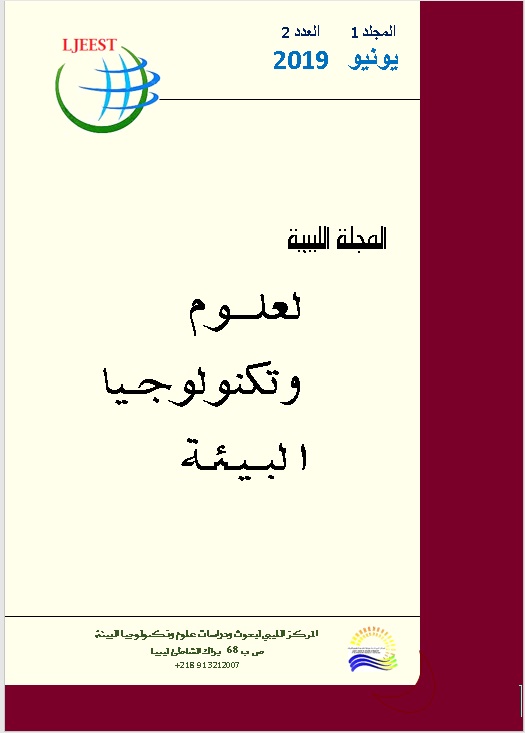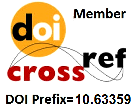استخدام خوارزمية (ليفنبرغ ماركوارت) كدالة تنشيط للتنبؤ بمؤشر جودة المياه (WQI) في مدينة كاستامونو - تركيا
DOI:
https://doi.org/10.63359/8jfhe511الكلمات المفتاحية:
الشبكات العصبية الاصطناعية، سد كاراجوماك، مؤشر جودة المياهالملخص
استخدام الشبكة العصبية الاصطناعية (ANN) ( برنامج كمبيوتر) لاجراء تنبؤ (توقع) لمؤشر جودة المياه (WQI) في مدينة كاستامونا - تركيا. مؤشر جودة المياه يعطي وصف كامل لجودة المياه ضمن موقع محدد ووقت محدد اعتمادا علي بعض عوامل جودة المياه تمت خلال خمس سنوات (من يناير 2011 حتي ديسمبر 2015 ) طبقت شبكة التغذية المباشرة البسيطة باستخدام خوارزمية الانتشار الخلفي القياسية (Levenberg-Marquardt) (train-Lm) في النمؤذج. في هذه الدراسة ، تم استخدام طبقة مخفية واحدة للنمذجة مع عدد مختلف من الخلايا العصبية المخفية (n+ 1) و (2n+ 1) من عقد الإدخال. كشفت الدراسة التاثير المباشر لكمية الخلايا العصبية المخفية علي أداء النمؤذج ويمكننا أن نرى هذا النموذج لخوارزمية الانتشار الخلفي القياسية (Levenberg-Marquardt) كدالة تنشيط (train-Lm) هي الأمثل في الأداء للتنبؤ بمؤشر جودة المياه (WQI) مع خيارات فعالة للتنبؤ بجودة المياه السطحية وغيرها من المسطحات.
المراجع
Abdolmaleki, Ahangar, & Soltani. (2013). Artificial Neural Network (ANN) approach for predicting Cu concentration in drinking water of Chahnimeh1 Reservoir in Sistan-Balochistan, Iran. Health scope, 2(1), 31-38.
Almasri, & Kaluarachchi. (2005). Modular neural networks to predict the nitrate distribution in ground water using the on-ground nitrogen loading and recharge data. Environmental Modelling & Software, 20(7), 851-871.
Asuquo, & Etim. (2012). Water quality index for assessment of borehole water quality in Uyo metropolis, Akwa Ibom state, Nigeria. International Journal of Modern Chemistry, 1(3), 102-108.
Banejad, & Olyaie. (2011). Application of an Artificial Neural Network Model to Rivers Water Quality Indexes Prediction–A Case Study. Journal of American Science, 7(1), 60-65.
Bayazit, & Avci. (1997). Water resources of Turkey: potential, planning, development and management. International Journal of Water Resources Development, 13(4), 443-452.
Chaipimonplin. (2016). Investigation internal parameters of neural network model for Flood Forecasting at Upper river Ping, Chiang Mai. KSCE Journal of Civil Engineering, 20(1), 478-484.
Chatterjee, & Raziuddin. (2002). Determination of Water Quality Index(WQI) of a degraded river in Asansol industrial area(West Bengal). Nature, Environment and Pollution Technology, 1(2), 181-189.
Daliakopoulos, Coulibaly, & Tsanis. (2005). Groundwater level forecasting using artificial neural networks. Journal of hydrology, 309(1), 229-240.
Erturk, Gurel, Ekdal, Tavsan, Ugurluoglu, Seker, . . . Ozturk. (2010). Water quality assessment and meta model development in Melen watershed–Turkey. Journal of environmental management, 91(7), 1526-1545.
Faruk. (2010). A hybrid neural network and ARIMA model for water quality time series prediction. Engineering Applications of Artificial Intelligence, 23(4), 586-594.
Fletcher, & Goss. (1993). Forecasting with neural networks: an application using bankruptcy data. Information & Management, 24(3), 159-167.
Garcia, & Shigidi. (2006). Using neural networks for parameter estimation in ground water. Journal of hydrology, 318(1), 215-231.
Gazzaz, Yusoff, Aris, Ahmad , Ramli, & Mohammad. (2012). Artificial neural network modeling of the water quality index for Kinta River (Malaysia) using water quality variables as predictors. Marine Pollution Bulletin, 64(11), 2409-2420.
Hajnayeb, Ghasemloonia, Khadem, & Moradi. (2011). Application and comparison of an ANN-based feature selection method and the genetic algorithm in gearbox fault diagnosis. Expert systems with Applications, 38(8), 10205-10209.
Heydari, Olyaie, Mohebzadeh, & Kisi. (2013). Development of a neural network technique for prediction of water quality parameters in the Delaware River, Pennsylvania. Middle-East Journal of Scientific Research, 13(10), 1367-1376.
Imneisi, & Aydin. (2016). Water Quality Index (WQI) for Main Source of Drinking Water (Karaçomak Dam) in Kastamonu City, Turkey. J Environ Anal Toxicol, 6(407), 2161.
Jakeman, Letcher, & Norton. (2006). Ten iterative steps in development and evaluation of environmental models. Environmental Modelling & Software, 21(5), 602-614.
Juahir, Zain, Toriman, Mokhtar, & Man. (2004). Application of artificial neural network models for predicting water quality index. Jurnal Kejuruteraan Awam, 16(2), 42-55.
Kaastra, & Boyd. (1995). Forecasting futures trading volume using neural networks. Journal of Futures Markets, 15(8), 953-970.
Karul, Soyupak, Çilesiz, Akbay, & Germen. (2000). Case studies on the use of neural networks in eutrophication modeling. Ecological Modelling, 134(2), 145-152.
Khalil, Awadallah, Karaman, & El-Sayed. (2012). Application of artificial neural networks for the prediction of water quality variables in the Nile Delta. Journal of Water Resource and Protection, 4(6), 388.
Kim, Loucks, & Stedinger. (2012). Artificial neural network models of watershed nutrient loading. Water resources management, 26(10), 2781-2797.
Maier, & Dandy. (2000). Neural networks for the prediction and forecasting of water resources variables: a review of modelling issues and applications. Environmental Modelling & Software, 15(1), 101-124.
Maier, Jain, Dandy, & Sudheer. (2010). Methods used for the development of neural networks for the prediction of water resource variables in river systems: current status and future directions. Environmental Modelling & Software, 25(8), 891-909.
Manoj, & Padhy. (2014). Multivariate statistical techniques and water quality assessment: Discourse and review on some analytical models. International Journal of Environmental Sciences, 5(3), 607.
May, Dandy, Maier, & Nixon. (2008). Application of partial mutual information variable selection to ANN forecasting of water quality in water distribution systems. Environmental Modelling & Software, 23(10), 1289-1299.
Moasheri, Khammar, Poornoori, Beyranvand, & Soleimani. (2013). Estimate the spatial distribution TDS the fusion method Geostatistics and artificial neural networks. International Journal of Agriculture and Crop Sciences, 6(7), 410.
Najah, Elshafie, Karim, & Jaffar. (2009). Prediction of Johor River water quality parameters using artificial neural networks. European Journal of Scientific Research, 28(3), 422-435.
Nasir, Juahir, Roslan, Mohd, Shafie, & Ramli. (2011). Artificial Neural Networks Combined with Sensitivity Analysis as a Prediction Model for Water Quality Index in Juru River, Malaysia. International Journal of Environmental Protection.
Nasr, & Zahran. (2014). Using of pH as a tool to predict salinity of groundwater for irrigation purpose using artificial neural network. The Egyptian Journal of Aquatic Research, 40(2), 111-115.
Panda, Garg, & Chaubey. (2004). Artificial neural networks application in lake water quality estimation using satellite imagery. Journal of Environmental Informatics, 4(2), 65-74.
Qiuhua, Lihai, Tingjing, Lei, Teng, Guojia, . . . Cunxiong. (2014). Use of principal component scores in multiple linear regression models for simulation of chlorophyll-a and phytoplankton abundance at a karst deep reservoir, southwest of China. Acta Ecologica Sinica, 34(1), 72-78.
Rooki, Ardejani, Aryafar, & Asadi. (2011). Prediction of heavy metals in acid mine drainage using artificial neural network from the Shur River of the Sarcheshmeh porphyry copper mine, Southeast Iran. Environmental earth sciences, 64(5), 1303-1316.
Sakthivel, Ravichandran, & Alagumurthi. (2016). Modeling and Prediction of flexural strength of hybrid mesh and fiber reinforced cement- based comosites using Artificial Neural Network (ANN). international journal of Geotech.,Const.Mat. and Environmental, 10(1), 1623-1635. doi: 2186-2990
Singh, Basant, Malik, & Jain. (2009). Artificial neural network modeling of the river water quality—a case study. Ecological Modelling, 220(6), 888-895.
Srinivasan, Dipti Liew, & AC Chang. (1994). A neural network short-term load forecaster. Electric Power Systems Research, 28(3), 227-234.
SUJANA, VERMA, & SHWETA. (2015). Application of ANN model for the prediction of Water Quality Index. International Journal of Engineering Research and General Science, 3(1).
Swingler. (1996). Applying neural networks: a practical guide: Morgan Kaufmann.
Tyagi, Sharma, Singh, & Dobhal. (2013). Water quality assessment in terms of water quality index. American Journal of Water Resources, 1(3), 34-38.
Wechmongkhonkon, & Areerachakul. (2012). Application of Artificial Neural Network to Classification Surface Water Quality. World Academy of Science, Engineering and Technology, International Journal of Environmental, Chemical, Ecological, Geological and Geophysical Engineering, 6(9), 574-578.
Wu, Dandy, & Maier. (2014). Protocol for developing ANN models and its application to the assessment of the quality of the ANN model development process in drinking water quality modelling. Environmental Modelling & Software, 54, 108-127.
Yesilnacar, Sahinkaya, Naz, & Ozkaya. (2008). Neural network prediction of nitrate in groundwater of Harran Plain, Turkey. Environmental Geology, 56(1), 19-25.
Yisa, & Jimoh. (2010). Analytical studies on water quality index of river Landzu. American Journal of Applied Sciences, 7(4), 453.
YUAN, GONG, ZHANG, & WANG. (2013). Forecasting the water quality index in Zaohe River based on BP neural network model [J]. Journal of Safety and Environment, 2, 023.
Zhang, & Stanley. (1997). Forecasting raw-water quality parameters for the North Saskatchewan River by neural network modeling. Water research, 31(9), 2340-2350.
















